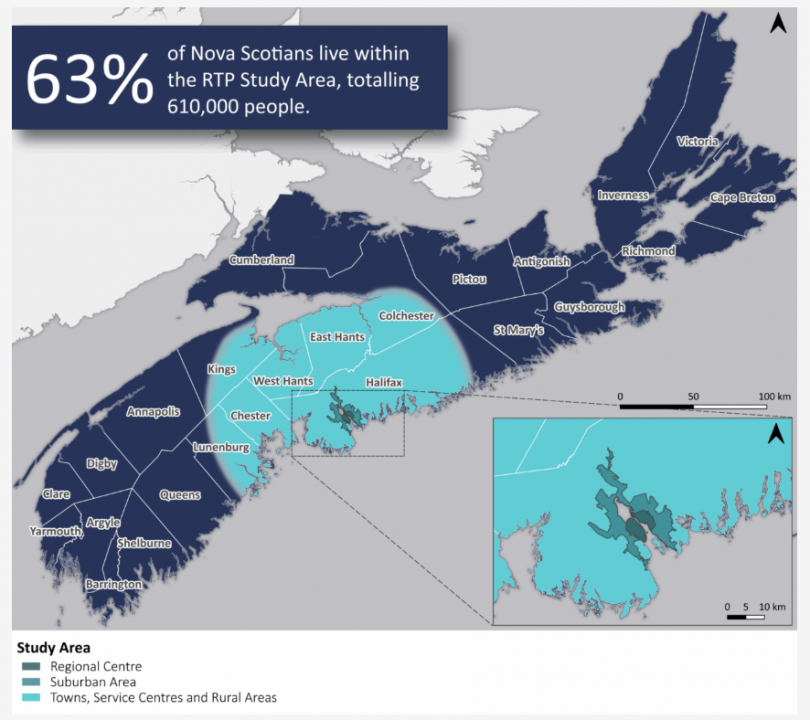Regional Transportation Plan Released

Dartmouth (foreground) and Halifax are pictured in 2024. The Regional Transportation Plan was released today, August 6, after a comprehensive review of all modes of transportation within 100 kilometres of Halifax. (Province of Nova Scotia / File)
The Regional Transportation Plan, released today, August 6, presents a series of actions to transform the transportation system over the next 20 years and beyond.
The first of its kind in Atlantic Canada, the plan offers solutions to manage the challenges of growth – targeted infrastructure interventions, increased transportation options, better goods movement, integration of new technologies, more efficient land use and transportation planning, and evaluation metrics.
“The RTP is a blueprint for the future of regional transportation,” said Public Works Minister Fred Tilley. “It’s a baseline for the Province to work in collaboration with partners, and it will help guide us as we continue planning for growth and development. It will also support the prioritization of significant infrastructure projects and identify potential funding as we begin to address the greater needs of the travelling public.”

The Regional Transportation Plan includes this map of the study area. (Link Nova Scotia)
The Province has identified several projects for preliminary work:
- conduct a Halifax peninsula core street review
- work with partners and existing systems to begin establishing a regional transportation management centre and intelligent transportation systems
- develop a strategy to launch an inter-municipal bus service
- investigate corridors for conversion to high occupancy vehicle lanes
- explore future road corridors in the region, including Shearwater and Beaver Bank connectors
- explore options for future fixed harbour crossings
- conduct corridor reviews of the Macdonald Bridge and Young Street
- review active transportation projects to preserve existing road capacity
- explore future harbour ferry terminal locations.
Work has advanced on several previously announced projects from the plan, including:
- initial surveys, traffic studies and environmental screenings for upgrades and improvements to Highway 102
- preliminary planning work to develop a new road connection between Hammonds Plains Road and Highway 101 (Exit 2)
- request for proposal package to be released for the passenger rail feasibility study
- funding provided to continue and expand the Student Transit Pass Pilot Program
- $65 million contributed to the Mill Cove ferry project.
Link Nova Scotia, formerly the Joint Regional Transportation Agency, was created in 2021 to address transportation issues and opportunities to support Nova Scotia’s population growth.
It was tasked with doing a comprehensive review of all modes of transportation within 100 kilometres of Halifax Regional Municipality and presenting recommendations to the Province.
Quotes:
“Halifax Harbour Bridges is pleased to see the government taking a proactive approach to the transportation needs of our growing province. We are especially pleased that the importance of our bridges is recognized in the plan, and we look forward to working with Link NS and its collaborating partners to ensure the continued safety and efficiency of all our transportation infrastructure.”
— Tony Wright, CEO, Halifax Harbour Bridges
“We are pleased to see the culmination of many months of work by those involved in developing this exciting plan, including our team at HIAA. Strengthening transportation linkages between the airport and communities across Nova Scotia is crucial for supporting economic growth, tourism and improved accessibility. We look forward to continued progress and the future expansion of transportation infrastructure and services that connect Halifax Stanfield with the communities we proudly serve.”
— Joyce Carter, President and CEO, Halifax International Airport Authority
Quick Facts:
- work on the Regional Transportation Plan began in 2023, when Link Nova Scotia engaged consulting partner HDR Corporation
- following best practices from other regions in Canada, Link Nova Scotia used scenario and network planning, as well as leading-edge tools such as an activity-based transportation demand model, to study transportation in the region
- the area studied includes 63 per cent of Nova Scotia’s population, 15 municipalities, five First Nations communities and 19 historic African Nova Scotian communities
- the plan was developed through an extensive engagement process and considered planning efforts from core partners including Halifax Regional Municipality, Halifax Harbour Bridges, Halifax Port Authority, Halifax International Airport Authority and the Atlantic Canada Opportunities Agency (ACOA)
Additional Resources:
Regional Transportation Plan and government response: https://linknovascotia.ca/regional-transportation-plan/
Link Nova Scotia:
- website: https://linknovascotia.ca
- Facebook: https://www.facebook.com/link.novascotia
- Instagram: https://www.instagram.com/link.novascotia
Department of Public Works on X: https://x.com/NS_PublicWorks